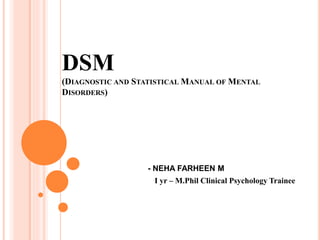
DSM
- 1. DSM (DIAGNOSTIC AND STATISTICAL MANUAL OF MENTAL DISORDERS) - - NEHA FARHEEN M I yr – M.Phil Clinical Psychology Trainee
- 2. CONTENTS I • Introduction • History / Short story of DSM II • Improvement in DSM-5 over DSM-IV TR • Structure of DSM-5 III • Similarities and Difference – DSM & ICD • Current controversies & Limitations.
- 3. INTRODUCTION What is DSM ? Diagnostic manual used by counselors, psychologists and psychiatrists; Help guide diagnostic decision making; Only classification system addressing mental disorders in current widespread use in most professional settings;
- 4. HISTORY
- 5. STORY OF DSM 1st version of 1952 and had 60 disorders; 1st & 2nd edition (1968) based on psychoanalytic traditions; 3rd version in favor of biomedical model (1980); DSM-III-R (1987) changed diagnostic criteria for several mental illness; DSM-IV (1994) had a interim text revision called DSM- IV-TR (2000) before it has now taken shape as DSM-5 (2013);
- 6. IMPROVEMENTS IN DSM-5 OVER DSM-IV TR Reflect developmental and life span approach; Gender-cultural issues integrated; Introduced new cross- cultural symptom measures; Guidelines for cultural formulation interviews; Latest evidence from genetics & neuroimaging taken into account to improve disorder descriptions; Substance abuse disorders restructured for clarity-consistency; Introduced a dimensional approach to diagnosis since many disorders are now thought to exist along a continuum than as distinct categories; Multi-axial system of DSM-IV eliminated in DSM-5; Global Assessment of Functioning Scale which had poor reliability and validity replaced with Disability Assessment Schedule;
- 7. IMPROVEMENTS IN DSM-5 OVER DSM-IV TR (CONT…..) Added optional alternative model for diagnosis of personality disorders; Restructured order of chapters; Aspergers and PDD consolidated into ASD as there was no evidence to support their separation; Diagnostic criteria for bipolar and depressive disorders streamlined; New diagnostic categories include: Disruptive Mood Dysregulation Disorder; Hoarding Disorder; Binge Eating Disorder; Excoriation Disorder; Revised Diagnosis: Internet-use Gaming Disorder; Non- suicidal self injury; Suicidal Behavior Disorder; Rejected proposed disorders: Anxious Depression; Hypersexual Disorder; Parental Alienation Syndrome; Sensory Processing Disorder;
- 8. STRUCTURE OF DSM-5… Section 1 includes an introduction and instructions on how to use the new version; Section 2 covers the diagnostic categories; Section 3 includes conditions that need additional research, a glossary of terms, and other important information.
- 9. DSM & ICD: SIMILARITIES... Both are diagnosis and categorizing manuals require two or more symptoms to make a diagnosis; Both are NOT self diagnosis manuals; Intended for use by qualified health professionals, more specifically psychiatrists; Both are officially recognized manuals used to categorize and diagnose mental disorders; Attempts are on to further harmonize between the two systems of disease classification;
- 10. DSM & ICD: DIFFERENCES…1 Internationally, DSM used mainly in the USA; ICD is larger manual, encompasses all types of diseases/disorders; Only chapter V is relevant for mental disorders; DSM is purely for mental disorders; ICD brought out of international collaboration; ICD produced by a global health agency with a constitutional public health mission; DSM issued by single national professional body-American Psychiatric Association; ICD primary focus on classification is to help countries to reduce burden of mental disorders. Its development is global, multidisciplinary and multilingual; DSM primary constituency is U.S. Psychiatrists; ICD approved by World Health Assembly comprising of 193 member countries; DSM approved by assembly of APA members; ICD is low cost and available free on internet; DSM is copyrighted and generates income for APA;
- 11. DSM-ICD DIFFERENCES…2 DSM criteria very specific and detailed ICD more of prototype descriptions with less detailed criteria and minimum background information to guide diagnosis; DSM always been multi-axial except now. ICD always been non-axial; DSM used by licensed mental health professionals with advanced degrees; ICD accessible to wide rage of health care professionals with wide educational backgrounds; Conceptual differences; Ex: Bulimia nervosa is characterized by ’morbid dread of fatness’ while DSM requires ‘self evaluation’; PTSD is much broader in ICD-10 than DSM5; Differences can cause problems in research comparisons; ICD-11 expected in 2017
- 12. CURRENT CONTROVERSIES..1 Dimensional vs. Categorical Approaches; Do mental disorders really exist? Single disorders rarely exist in pure text book form; Separate disorders vs. sub types; Diagnosis of mental disorders is dubbed as subjective; No biomarkers or genetic markers, lab tests, blood tests, brain scans as basis for diagnostic criteria; Mostly based on patient self reports or key informant reports; Subjectivity is inevitable to some extent; Financial implications of revising diagnostic classifications; Manual is based on the biomedical model; No clear line of demarcation between normal-abnormal; Manual itself says that it should not be used as ‘cookbook’;